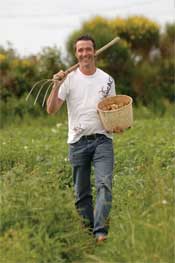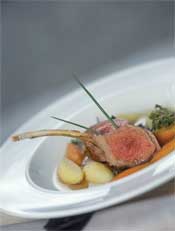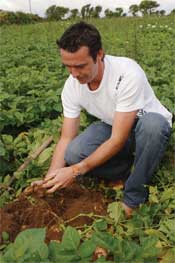Roast Rack of Lamb in Irish Stew Consommé - Potatoes
Great Balls of Flour
The whole world turns green this week, and a major Irish food and tourism promotion is taking place in America, where Tourism Ireland is introducing a team of six  Irish chefs as guests, where they will work with American counterparts at a number of prestigious St Patrick’s Week events in Boston and New York. The team represents all that is best about the Irish food scene, North and South, with a balanced choice of members from different areas, age groups and types of establishment painting a fair picture of the best that the visitor might expect to find here in this special Ryder Cup year.
Irish chefs as guests, where they will work with American counterparts at a number of prestigious St Patrick’s Week events in Boston and New York. The team represents all that is best about the Irish food scene, North and South, with a balanced choice of members from different areas, age groups and types of establishment painting a fair picture of the best that the visitor might expect to find here in this special Ryder Cup year.
Chef Kevin Dundon, proprietor-chef of Dunbrody Country House Hotel & Cookery School in Arthurstown, Co Wexford, is an old hand at this stage and plays a leading role again this year, and other members of the team include key speaker Darina Allen, Neven Maguire of MacNean Bistro in Blacklion Co Cavan, Michael Deane of Restaurant Michael Deane in Belfast, Richard Harte Executive Head Chef of Glenlo Castle Hotel, Galway, and David McCann Executive Head Chef at Dromoland Castle, Co Clare.
It is the first time that this special annual promotion has focused on Ireland as a food destination and, with such a strong team to represent us, it is sure to be a wow.
Roast Rack of Lamb in Irish Stew Consomm�
Kevin Dundon, who cooked this dish to great acclaim at the James Beard Dinner in New York last March, is a man who understands the timeless appeal of a bowl of steaming hot stew. This is a sophisticated version of Irish Stew that he has developed over the years, but the main ingredients are still the same as his mother uses, and her mother before her. It features in his book Full On Irish (hardback EUR25), a recently announced winner in the Gourmand World Cookbook Awards.
Serves 4:
 1kg/2 1/4 lb scrag end of neck of lamb
1kg/2 1/4 lb scrag end of neck of lamb
2 leeks
2 carrots, roughly chopped
1 large onion, finely diced
2 celery sticks, roughly chopped
1 large bay leaf
1 large fresh thyme sprig
small handful flat-leaf parsley stalks
few black peppercorns
2 x 6-bone best ends of lamb, each about 275-350g/10-12oz
175g/6oz small carrots
275g/10oz baby new potatoes
1 tbsp/1 1/4 US tablespoons olive oil
salt and freshly ground black pepper
fresh rosemary and thyme sprigs, to garnish
Place the neck of lamb in a large pot. Roughly chop one of the leeks and add with the roughly chopped carrots, half of the onion, the celery, herbs and peppercorns. Cover with at least 1.75 litres/3 pints/8 cups of cold water. Bring to the boil, season lightly and then simmer gently, uncovered, for about 2 hours until reduced by nearly two-thirds - you'll need 450ml/3/4 pint/2 cups of lovely, sweet stock in total. Skim off any scum or grease that rises to the surface with a large spoon. Strain the stock through a fine sieve into a large jug and ideally leave to cool overnight so that you can scrape off any fat that has settled on top.
Preheat the oven to 200ºC/400ºF/Gas 6. Season the racks of lamb and place in a small roasting tin. Roast for 20-25 minutes, or a little longer, depending on how pink you like your lamb. Remove from the oven and set aside in a warm place to rest for 10-15 minutes.
Meanwhile, peel and shape the small carrots and baby potatoes into neat barrels. Add to the lamb stock with the remaining onion and bring to a simmer. Cook gently for 10-15 minutes until the carrots and potatoes are completely tender but are still holding their shape. Season to taste.
Meanwhile, heat the olive oil in a frying pan. Cut the remaining leek into julienne (long thin strips) and add to the pan, then saut� for 3-4 minutes until softened but not coloured. Season to taste.
To serve, carve the rested racks of lamb into chops. Place the leek julienne in the centre of each warmed wide-rimmed serving bowl and spoon around the Irish stew consomm�. Arrange the lamb chops on top of the leeks and garnish with the rosemary and thyme sprigs.
Book Review
The humble tuber my not be an obvious subject for a coffee table book but ‘Potato’. by Lindsay and Patrick Mikanowski with photography by Grant Simon (Grub Street, £25, hardback), is just that. It is a very large format book, with considerable presence – and, although it does offer a selection of potato recipes from top chefs around the world (not including Ireland alas), it’s hard to imagine this book getting dog-eared on your kitchen worktop.
But, although not an obvious friend to the everyday cook, it is a beautiful book and a useful reference, which you might find yourself turning to more often than expected. The origins, history and importance of the potato are well covered, also the potato garden (‘how to grow’), and there is extensive information on the different varieties and their characteristics - demonstrated in the recipes: ‘The focus of this book is the meeting of an international potato with the chefs of the world. It therefore necessarily reflects contemporary cooking. It is not written in praise of fusion cuisine, rather it puts the case for diffusion cuisine. The potato is universal and belongs to everyone’. Rarefied, perhaps, but interesting.
 Ingredient of the Week: Potatoes
Ingredient of the Week: Potatoes
What exactly are they? A tuberous rooted perennial originally from the Andes, now widely grown as an annual for its edible tubers. These are used throughout the year and are a staple source of starch. Varieties are listed in three groups according to the time of maturing first early second early and main crop. (Only main crop potatoes keep well through the winter). Varieties vary according to local conditions.
What should I look for? In Ireland and Scotland, good first earlies include Arran Piper and Home Guard; second earlies include Pink Fir Apple (good for salads) and the very popular Queen’s (British, Rush, Dublin etc depending on the locality and your point of view) and reliable main crops include the superb floury Golden Wonder (a good baker) and that great all-rounder, Rooster. A ‘soapy’ potato that holds its shape without breaking up is favoured in most countries – Irish taste is unique in preferring ‘balls of flour’; all of the varieties above have good flavour but this is not always the case. Although small, the ubiquitous so-called ‘baby potatoes’ should not be confused with real new potatoes: they have gained favour for convenience - so easy to ‘hold’, and to portion in restaurants, so easy to sell in supermarkets – but they have poor texture and flavour.
Where do I get them? The familiar plastic-wrapped tubers are available at every corner store; look for named varieties, preferably with the name of the producer. Wilson Country Potatoes from Northern Ireland are especially highly regarded (and are among the small number of products to have been recognised by an Irish Food Writers Guild ‘Good Food Award’, a few years ago), and there are many fine potato growers throughout Ireland who are proud to put their name to the product. Potatoes are frost-sensitive and, traditionally, St Patrick’s Day is the time when it is reckoned safe to plant out the new crop. You don’t have to have a huge garden to grow a few spuds – why not get a few early seed potatoes such as Home Guard from your local garden centre this weekend and grow them in a tub? They’ll be ready to harvest once the flowers appear in July – then you can enjoy the incomparable flavour of real new potatoes, cooked in milk and water with a sprig of mint,..Deelish
What can I do with them? Nobody knows better than our readers all the things you can do with this most versatile of foods. You’ll find that buying bags of mixed sizes will be most useful for different cooking techniques, eg big ones for baking, medium sized for roasting, small ones to scrub and steam.





There are currently no comments
Leave a comment
Not a member? Register for your free membership now!
Or leave a comment by logging in with: